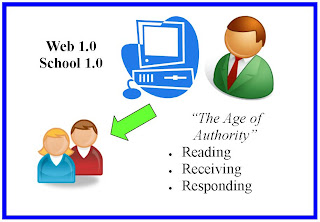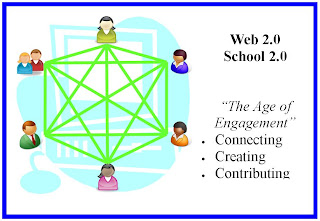 I gave the keynote address to the CVCUE meeting in Fresno this past Saturday, and prepared a presentation on why Web 2.0 is going to be so important to education. When I was driving home I made a connection that I hadn't fully made before: that the transition between Web 1.0 and Web 2.0 is very similar, if not almost identical to, the change between School 1.0 and School 2.0.
I gave the keynote address to the CVCUE meeting in Fresno this past Saturday, and prepared a presentation on why Web 2.0 is going to be so important to education. When I was driving home I made a connection that I hadn't fully made before: that the transition between Web 1.0 and Web 2.0 is very similar, if not almost identical to, the change between School 1.0 and School 2.0.Now, in retrospect, it seems obvious that the technology that is most significantly reshaping our culture and business (Web 2.0) would also have the potential to dramatically change how we view education, but I hadn't really defined the parallels in my own mind. These two simple graphics describe what I'm seeing.
Web 1.0 came out of our existing mindsets of how information is transferred, and very much reflected the 100+ year history of industrialism, with experts/businesses dispensing identical knowledge/products to mass consumers.

Web 2.0 has really been the flowering of new relationships between individuals and businesses, and reflects new ways of thinking that the technology has facilitated or created. It's about engaged conversations that take place directly, and don't rely on top-down management, but peer feedback and mentoring. It's an incredibly effective restructuring of how learning takes place, and somehow we have to figure out how to bring this experience into our learning institutions--or they will become obsolete.
----
Cross-posted from www.SteveHargadon.com. OK, Classroom 2.0 folks, is this on the mark? What do you think?
-
Comment by Jeremiah Patterson on April 25, 2007 at 7:55am
-
Sure, this is on the mark. I often wonder, though, about the lag time between now and when the connectivist age really catches hold. I see a fundamental choice between a) barreling straight ahead, coming out on the other side with all integrity intact & b) popping a head up now and again to encourage others to join. In the end, the latter is the preferred option, I think, because it fits with the connectivist nature of the whole 2.0 'thing.'
I'm not sure if that made sense. My concern is that learning -- and schooling -- will not change rapidly enough to suit me (like by the time my six-week old is in kindergarten), but on the other hand knowing that change takes eons (or so it sometimes seems) and that it is important to meet folks where they stand.
-
Comment by Steve Hargadon on April 25, 2007 at 7:59am
-
Some clarification I made on my external blog:
I have been writing and talking about the connection between the technologies of Web 2.0 and the pedagogies they support for some time, and one of my struggles has been that the pedagogies supported are not necessarily new. In some ways Web 2.0 technologies open the door to older discussions, and in some ways they create new learning opportunities.
What this direct parallel between Web and school has done for me has made it easier to talk about. It makes a connection between what's happening on the web and what can/should take place in schools--and recognizing that the technology seems to underlie the opportunity to change and to drive it at the same time.
I was speaking to 200 educators, 4 of whom raised their hands when I asked how many were blogging. I continue to be surprised at just how much this discussion is still outside of mainstream--although I think it is gaining incredible speed. So on that drive home my thinking revolved around finding an easy way to communicate what is taking place with those new to the discussion.
-
Comment by Torsten Otto on April 25, 2007 at 1:04pm
-
Your thoughts are right on the mark, Steve, or at least: I fully agree.
Interesting to me is not only "just how much this discussion is still outside of mainstream", but that this is true for both teachers and students. A number of students is not readily accepting of School2.0. It is just so much easier to sit back and consume the program so when I teach - strike that: organize my classes in a more constructivist way, some feel lost, wish for a clear structure of what specific tasks are to be solved by what means...
-
Comment by Steve Hargadon on April 25, 2007 at 1:30pm
-
Yes, I am frequently reminded that "digital natives" may have grown up with the technology, but they've mostly been swimming on the surface only and most don't have the kind of deep understanding that is too easy to assume since they are using the technologies.
-
Comment by Paul Reid on May 21, 2007 at 6:42am
-
Hi Steve,
These graphics are simple and powerfully descriptive to visual learners. Are you releasing these under a Creative Commons licence?
The move to school2.0 is really going to be an ideological shift. As many have recocognised web2.0 is not a thing rather a way of thinking. School2.0 may not even be a traditional walled environment.
I like to refer to a web 2.0 mantra of sorts as described at a recent Jimmy Wales (founder of wikipedia) visit to Perth, Australia:
"We need to learn to contribute and disagree in safety".
-
Comment by Steve Hargadon on May 21, 2007 at 8:21am
-
Thanks, Paul. The graphics and post were originally posted at www.SteveHargadon.com, which is licensed under a Creative Commons Attribution-NonCommercial-NoDerivs 2.5 License. Please feel free to use the graphics and attribute.
-
Comment by clyde mann on June 8, 2007 at 11:01pm
-
Graphics molding with content is great. This is what makes up Web 2.0. Being a Library Media teacher/ instructional technologist, we have a long way to go to school 2.0. Let me give you a brief example: I had a group of remedial algebra teachers come into my lab today. The teacher wanted her kids pacified in front of visual algebra tutorials. I took the kids to an Intranet site on our server. They had the opportunity to choose from seven different algebra videos. They started watching them. The kids liked them, but were easily distracted. I asked a couple of kids what would make the video better. Their answer was simple, " They showed us the reason for doing the math, they showed us an example, but where are examples that we could do, with prompts that would help us and correct it for us?"
I have done extensive research and know how to develop these kind of tutorials on the front end to make today's learners engaged. Unfortunately, I do not have the back end skills.
What many people do not understand is how most kids learn today. Over 70% of students that I surveyed needed some form of visual prompt to understand an academic concept. (They can optimally learn academic material today in the same fashion that an ESL student learns acquires English)
Nobody is addressing this in educational circles. Steve, if you are open to collaborate on this, let's talk.
-
Comment by Peggy Soong Yaplee on June 22, 2007 at 12:19am
-
Steve, great graphics and definitely demonstrates how far we have come in this particular area. Many of the comments ring true for me as a technology specialist and a PhD graduate student. Many of the books, research and studies I have been reading around Internet 2.0 tools and how children learn is very interesting. We can no longer talk about literacy as just read and write, but there are so many ways children learn now through audio, video, print, etc.
One of the things I find when doing professional development with teachers is trying to convince them that it's ok for students to do their reading online, but I still get the teachers who insist on putting a book into a student's hand rather than letting them go online. It is hard to convince teachers to think like their kids and use what they do to incorporate into their teaching.
Many teachers don't like kids who do text messaging, but I encourage it because it as a form of writing for many of the high school students that I work with. I tell them they have to text message me with their concerns about my class. Through this activity, they learn to get their points and needs across in a very concise manner and learn to communicate to me in a very direct and simple way.
I then use this skill with students when they read an article and have to find the main ideas. I will then tell them to take notes on the article by writing down the key concepts and idea in just a few sentences. A lot of students struggle with this, but when I tell them to think of it as a text message, they seem to have no problem figuring out how to write down the key concepts and idea then. This is the form of scaffolding I do when teaching kids how to take notes.
Comment
© 2025 Created by Steve Hargadon.
Powered by
![]()
You need to be a member of Classroom 2.0 to add comments!
Join Classroom 2.0